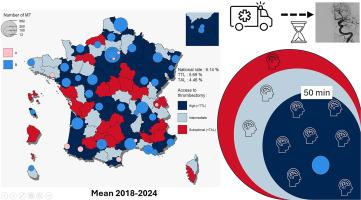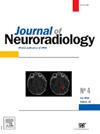定义最佳血栓切除术每缺血性中风的目标:一种方法,指导每中心的程序量在法国
IF 3.3
3区 医学
Q2 CLINICAL NEUROLOGY
引用次数: 0
摘要
背景和目的机械取栓术(MT)已成为治疗大血管闭塞性中风的突破性方法。基于区域人口统计数据、人群与取栓中心的理想距离以及适当的缺血卒中取栓率中心的预期取栓数量的数据有限。材料和方法本回顾性分析(2018-2024)使用法国国家统一医院出院数据集的数据来建立指导公共卫生政策的基准指标。我们将取栓目标水平(TTL)定义为每缺血卒中标准化取栓率的中位数,将取栓警戒水平(TAL)定义为所有行政区域每卒中标准化取栓率的第25百分位。这些阈值每年计算一次,并绘制百分比图。使用TTL和血栓切除治疗的中风病例的分布作为距离的函数,我们确定了实现这一目标的最大汽车行驶时间。结果在研究期间,PMSI报告了803058例中风和49154例血栓切除术(占所有中风的6.1%)。TTL从2018年的4.4%上升到2024年的7.0%,TAL从3.6%上升到5.6%。标准化取栓/缺血性卒中比率的地理分布揭示了不同地区取栓治疗水平的差异。为了达到生存时间目标,人群应在距离取栓中心50分钟车程的范围内。我们设置了流行病学阈值作为目标(TTL)和警报(TAL),以识别未充分切除血栓的地区。公共卫生当局可以使用这些阈值来调整和优化医疗保健服务。为了获得最佳的访问,人们应该在距离中心一个小时的车程内。本文章由计算机程序翻译,如有差异,请以英文原文为准。

Defining optimal thrombectomy-per-ischemic-stroke targets: a methodology for guiding procedure volumes per center in France
Background and purpose
Mechanical thrombectomy (MT) has emerged as a groundbreaking treatment for large vessel occlusion strokes. There is limited data on the expected number of thrombectomies based on regional demographics, the ideal proximity to thrombectomy centers for the population, and the appropriate thrombectomy-per-ischemic-stroke ratio centers should target.
Materials and methods
This retrospective analysis (2018–2024) used data from the French National Uniform Hospital Discharge Dataset to establish benchmark indicators guiding public health policy. We defined the Thrombectomy Target Level (TTL) as the median standardized thrombectomy-per-ischemic-stroke ratio and the Thrombectomy Alert Level (TAL) as the 25th percentile of the standardized thrombectomy-per-stroke ratio across all administrative regions. These thresholds were calculated annually, and percentages were mapped. Using the TTL and the distribution of thrombectomy-treated stroke cases as a function of distance, we determined the maximum car travel time to achieve this goal.
Results
Over the study period, 803,058 strokes and 49,154 thrombectomies (6.1 % of all strokes) were reported in the PMSI. TTL rose from 4.4 % in 2018 to 7.0 % in 2024 and TAL rose from 3.6 % to 5.6 %. The geographic distribution of standardized thrombectomy-per-ischemic-stroke ratio revealed disparities in thrombectomy treatment levels across regions. To meet TTL objectives, the population should be within 50 min by car from a thrombectomy center.
Conclusion
We set epidemiological thresholds as targets (TTL) and alerts (TAL) to identify regions performing insufficient thrombectomies. Public health authorities can use these thresholds to adjust and optimize healthcare services. For optimal access, the population should be within an hour’s drive from a center.
求助全文
通过发布文献求助,成功后即可免费获取论文全文。
去求助
来源期刊

Journal of Neuroradiology
医学-核医学
CiteScore
6.10
自引率
5.70%
发文量
142
审稿时长
6-12 weeks
期刊介绍:
The Journal of Neuroradiology is a peer-reviewed journal, publishing worldwide clinical and basic research in the field of diagnostic and Interventional neuroradiology, translational and molecular neuroimaging, and artificial intelligence in neuroradiology.
The Journal of Neuroradiology considers for publication articles, reviews, technical notes and letters to the editors (correspondence section), provided that the methodology and scientific content are of high quality, and that the results will have substantial clinical impact and/or physiological importance.
 求助内容:
求助内容: 应助结果提醒方式:
应助结果提醒方式:


